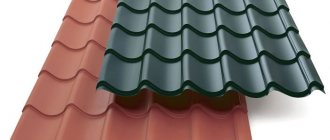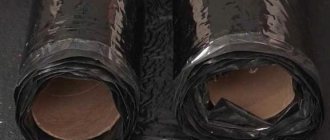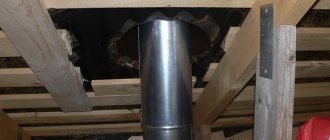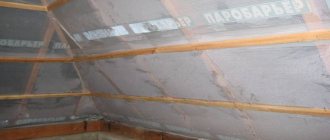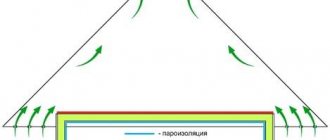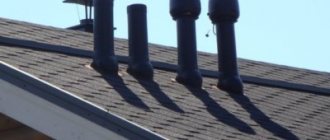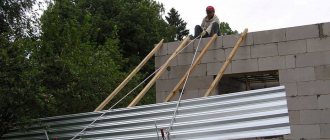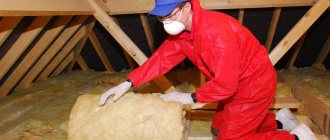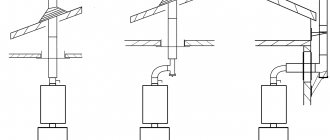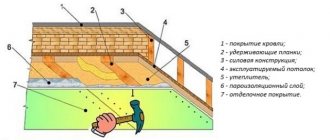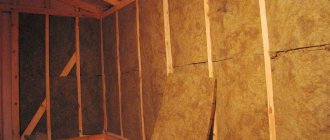In the construction of flat and slightly sloped roofing coverings, more powerful and reliable waterproofing is required; as an option, you can use roof waterproofing, roofing felt and bicrust sheets, modified bitumen and even liquid rubber. The high osmotic pressure of water and its vapor, extremely unfavorable conditions for the natural flow of liquid force the use of waterproofing for the roof. In such conditions, polypropylene film, like on a gable roof, is no longer enough.
Characteristics of roofing waterproofing
It just so happens that only professional builders and designers read state standards. Manufacturers and commercial companies that produce a variety of types of waterproofing, including roof waterproofing, even if they read GOSTs, it is only to borrow names and special terms from the text that attract buyers.
Therefore, you need to be extremely careful, since there are three types of roof coverings on the market called “Gidroizol”:
- Rolled roofing materials based on fiberglass or fiberglass impregnated with modified bitumen of various brands. As a rule, the manufacturer adds an alphanumeric marking like “TKP-4” to the name “hydroizol”, by which the structure and weight of the coating can be determined;
- Mastic or liquid bitumen materials based on sulfur-free bitumen with a melting point of 4-15 ° C. This type of liquid waterproofing for roofing is not used independently; it is most often used for applying a lining layer or waterproofing abutment areas;
- Roofing waterproofing in rolls, manufactured in accordance with the requirements of GOST 7415-86 or GOST 30547-97.
Advice!
When drawing up a roofing installation project, it is necessary to detail in as much detail as possible the requirements for what kind of waterproofing is needed for the roof, with a description of the structure and, preferably, an indication of the manufacturer. Why is this so important?
Because waterproofing for roofing, the properties, characteristics and structure of which are determined by state standard No. 7415-86, differs significantly from those related by name glass hydroisol or commercial “TKP Hydroisol”. It is even more necessary to pay attention to the state of aggregation, because liquid waterproofing for roofing is used only as an auxiliary material.
Video description
The video shows how to repair roofs covered with different roofing materials using liquid waterproofing:
It should be noted that laying waterproofing as a finishing coating for roofs is just part of where it can be used. With its help, flexible tiles, or more precisely, their under-roofing carpet, are installed not only along the entire surface of the covering, but also in places where the roofing material adjoins, on valleys, eaves and ridges.
Today mastic is used in private housing construction as a waterproofing for foundations. It is simply applied in two layers using a spray bottle. Steel or cast iron pipes can be waterproofed in the same way.
Properties of Gost waterproofing agent
It is clear that GOST, compiled in the 80s of the last century, was based on the materials and technologies of that time, so one cannot expect any particularly outstanding characteristics from the original waterproofing material. In fact, this is an analogue of the long-known and well-known roofing felt made from paper and bitumen.
The main characteristics of roof waterproofing are as follows:
- Panel sizes. Width - 0.95 m, length per roll - 20 m, web thickness - 0.9 mm;
- Tensile strength – 27 kg, daily water absorption – 6%;
- The basis for waterproofing is asbestos kraft paper or asbestos cardboard impregnated with bitumen emulsions;
- The insulating material is GI-K bitumen with increased resistance to oxygen and ultraviolet radiation.
The surface of the canvas does not have a sand and gravel powder; the bitumen is only sprinkled with talc powder in order to avoid gluing in rolls. In appearance, it is a thin fabric of dark brown or oily black color, relatively soft and fragile.
GOST 7415-86 waterproofing is seriously inferior in mechanical and insulating characteristics to modern materials with similar names. For example, steklogidroizol is a 3 mm thick canvas made of GI-K bitumen based on fiberglass. The strength is two times higher, and the waterproofing characteristics are three times higher than the GOST material.
For your information! To avoid confusion, many construction departments and organizations have documented restrictions on the use of waterproofing in accordance with GOST No. 7415-86 for roofing work, recommending more advanced materials based on fiberglass and polyester mesh.
But this does not mean that traditional waterproofing in roll and liquid form cannot be used for roofing in home construction.
How to choose the right coating
Structure of waterproofing
Before buying waterproofing, decide for what purpose you are purchasing it. For lining under roofing or for waterproofing, a so-called bottom layer is produced.
Note! For the final roof covering, it is better to purchase the top type, intended for roofing work without subsequent laying of other materials on it. This type can be identified by the letters on the packaging. The letters KhPP and TPP mean that the first option contains canvas, and the second – fiberglass. The letter P indicates the presence of a polymer protective film.
For the top types of coating there is a letter K on the packaging (HKP and TKP), it makes it clear that the material uses coarse-grained mineral powder. It not only gives strength, but also prevents the bitumen from melting under the influence of sunlight, as it reflects them.
It is advisable to store purchased waterproofing in a dry, ventilated area, at room temperature, in rolls.
Advantages and disadvantages of the material
The most significant advantage of Gostov waterproofing agent is its price and availability. The material turns out to be much cheaper than modern bitumen roofing sheets, and if installed correctly, it can last on the flat roof of a garage or shed for at least 10-15 years. This means that a master roofer will be able to make a fairly dense waterproofing of a flat roof even from waterproofing.
Advice! For beginners, when first trying to install a roof covering, it is better to use glass hydroisol or similar materials.
You should not expect outstanding technical characteristics from Gost waterproofing; in terms of its structure, it can be classified as a modern lining fabric. However, it is quite possible to make a roof covering using waterproofing GOST No. 7415-86. You just need to take into account certain restrictions:
- The roof cannot be laid on an unprepared covering; before gluing waterproofing to the roof, it is necessary to treat it with a primer or similar impregnation;
- The canvas cannot be laid using burners, despite the fact that the waterproofing material for roofing work on the roof has a non-flammable asbestos base; the material is easy to burn due to the small thickness of the canvas;
- The material does not have a protective surface layer of gravel, so after installation the surface is filled with liquid waterproofing and covered with a sand-gravel mixture.
The use of an asbestos fiber base makes it one of the most popular waterproofing coatings for metal welded structures. Thanks to asbestos, drops and splashes of molten metal do not penetrate through the waterproofing, and local damage to the bitumen sublayer can be easily patched with liquid insulation.
Material advantages
Gidroizol is a rolled material based on fiberglass or fiberglass, with a polymer-bitumen composition applied on both sides. There are varieties of products with a paper or cardboard base.
A special thin film is additionally applied to the reverse side of the rolls, which burns out and melts when the material is laid.
The front side is covered with coarse-grained mineral or granite chips. The material is ideal for covering flat roofs, as well as roofs with low slopes. It is often used as a waterproofing coating for foundations.
If you intend to waterproof your roof, you will need a type of roofing material that contains bitumen-coated cardboard. For foundations, a paper-based coating is used.
In principle, the difference between them is small, except that the roofing type is a little more expensive due to a thicker base, and a little heavier.
The fiberglass used in the production of the coating makes the material not only plastic, it gives it strength and resistance to moisture, fire and mechanical damage. Elasticity and ease of installation can also be added to a number of advantages.
Preparing the roof for laying waterproofing
A significant advantage in using asbestos-bitumen sheeting is the ability to lay it even on wooden surfaces. The roof slopes can have a slope of up to 10°, but the surface must be solid, for example, covered with clapboard, plywood or OSB panels.
To prepare, you will need to thoroughly clean the base, dry out moisture stains, and remove any remaining old paint or bitumen. Since waterproofing has a very small thickness of bitumen, it can only be laid on defect-free surfaces. Therefore, the roof sometimes has to be cleaned with a bronze brush and trimmed with a grinder.
The last stage of preparation is the application of impregnation. You can use the original composition or dilute a small amount of bitumen and resin in white spirit or kerosene and paint the base of the roof twice with a brush.
How to properly lay liquid waterproofing
In principle, for waterproofing it doesn’t matter what kind of surface it will treat. Rubber-like mastic covers any small defects, grooves, depressions and tubercles. But experts recommend cleaning the roof before laying waterproofing on the roof. That is, you need to remove debris and dust, at a minimum.
Now, after thorough mixing, the contents of the jar or bucket are poured onto the roof plane and evenly distributed over it with any painting tool: brush, roller or spatula. The main task of the work manufacturer is to carry out the pouring without stopping, so that hardened joints of two layers do not form on the plane.
After drying, a seamless coating is formed on the roof, quite durable and elastic. By the way, about the last quality. It is the elasticity of the material that gives it the ability to undergo temperature changes. That is, at low temperatures it compresses without forming cracks or tears, and at high temperatures it stretches. In the latter case, the thickness of the coating decreases, but the waterproofing does not break.
Liquid waterproofing even after drying is an elastic material Source kamtehnopark.ru
How to put waterproofing on the roof
The process of laying waterproofing must be treated with extreme care; one should not rush, especially when adjusting individual panels on the roof. There is a certain advantage in working with waterproofing for the lining, load-bearing and outer layers. Even if something lies unevenly somewhere, you can put an additional cloth. The thickness of the waterproofing sheet is small, so you can lay 4-5 layers without the risk of the insulation peeling off.
If you use glass hydroisol or any other similar material, you will have to strictly follow the technology, lay a lining layer, and then lay a more rigid bitumen sheet with high wear resistance.
At first glance, there is no difference, but this is not entirely true. Multilayer roofing covering made from waterproofing agent GOST 7415-86 is more flexible and better adapted to the roof surface. But its installation will require two to three times more time and effort than the installation of a modern glass hydroisol sticker.
Calculation of waterproofing consumption ↑
The amount of material required to create a waterproofing coating on the roof surface will depend on several factors:
- Angle of inclination of planes.
- Length and width of slopes.
- Covering areas.
The greater the slope of the roof planes, the better the removal of precipitation from its surface.
- If the roof slope is 45 degrees or more, only one layer of material will need to be laid.
- If the roof planes are inclined between 20 and 40 degrees, 2 waterproofing layers will be needed.
- If the angle of inclination is about 5-15 degrees, 3 layers of coating should be laid.
In addition to the exact quantity, you need to select the appropriate grades of material for roofing work.
Types of waterproofing ↑
Depending on the type, waterproofing fabric can be used for internal and external coatings, which in turn are used to create waterproof layers on the roof, floor, or foundation. Depending on the direction of work, the appropriate grades of waterproofing agent are used.
Specifically for roofing, canvases based on fiberglass, or fiberglass, are intended. The material is marked with abbreviations:
Hot styling
This is the most complex and reliable method of installing a sheet; instead of heating the material directly, you have to melt a mixture of bitumen and resin in a separate container and pour the melt under the unfolded roll, as is done when working with roofing felt.
The laid canvas is immediately rolled with a roller, and excess melt must be removed with a scraper. The next layers of waterproofing are laid offset by a quarter of the width of the panel. Upon completion of the sticker, the outer surface of the waterproofing is filled with liquid waterproofing and covered with a mixture of sand and screenings.
Application of hydroisol
Unlike roofing felt, waterproofing is suitable for insulating pipelines. In addition to the hero of the article, they contain brizol, heat-shrinkable and polyvinyl chloride tapes. In pipelines they work mainly with waterproofing mastic. It perfectly isolates joints in metal structures, avoiding chemical reactions with them.
Waterproofing is also useful in swimming pools. In them, water must be blocked at two levels. Internal waterproofing protects from groundwater, and external waterproofing protects from those in the bowl. If the pool is indoors, internal protection is also needed, but not as powerful.
With swimming pools, as well as with pipelines, they work mainly with mastic. Rolled waterproofing is used for foundations and roofs. They are flat, or with a slight slope. The hero of the article is not suitable for buildings with sharp changes in roof levels.
Sometimes, waterproofing is placed on the floor. This is true in damp rooms. The coating does not allow moisture to enter the room. True, before laying the tiles, you should make a reinforced screed. This is a special case of a reinforced concrete structure. You can also protect your garage or basement.
Before using the hero, articles are stored in dry, dark rooms without sudden temperature changes. Positive indicators are desirable. Heating devices should be at least a meter away from the rolls.
The rolls adjacent to each other is also undesirable. Without special layers, the “skeins” can stick together. This happens especially often during transportation. Waterproofing rolls are stored in a vertical position.
Laying of waterproofing is carried out down to -15 degrees Celsius. Temperatures below lead to cracking of the material when working with it. Once laid, the isolate can withstand temperatures down to -40 degrees. The statement concerns waterproofing compounds with polymer additives that increase plasticity and frost resistance.
Mechanical laying
It is quite possible to lay the GOST 7415-86 sheet mechanically. The first layer is laid on a flat roof, using raw rubber dissolved in a kerosene-gasoline fraction as a primer.
The remaining layers are laid on the roof with an overlap of 20 cm, with the edges coated with glue or mastic.
For your information! In the same way, you can lay waterproofing on a pitched roof, but in this case the first layer will need to be secured to the sheathing using a construction stapler.
Areas of use ↑
Despite the universal capabilities for laying and fastening to various types of material, the main area of application of waterproofing is the protection of concrete bases from moisture.
As a result, such roll waterproofing is used on flat types of roofs, most often not in use.
If you use this material on slopes collected from wood. Then you first need to assemble a continuous sheathing from OSB boards or boards. In the latter option, the gaps between the lumber should not exceed 10 mm!
For waterproofing coatings of foundations, separate brands of waterproofing agent are used!
Laying on bitumen mastic
Performing roofing using cold mastic is considered the most convenient and safe option, since there is no need to work with open fire. As in the hot version, the binder is applied immediately before the roll is unrolled, but the rolling of the waterproofing panels is carried out after unwinding all the material.
A day after installing the waterproofing, the outer layer is covered with gravel backfill.
Photo gallery of types of waterproofing installation
Hot laying of waterproofing
Laying waterproofing using bitumen mastic
Mechanical installation technology for waterproofing
Each of the listed technologies requires the performer to have certain skills and abilities. The mechanical laying method is considered less labor-intensive. If you decide to lay waterproofing yourself, we recommend that you choose it.
Tips and tricks
Waterproofing can be used as an insulating layer not only for the roof, but also to protect gables and seal flat areas in areas adjacent to the parapet. The material is used to seal the edges of the eaves and the fastening parts of the rafters to the roof mauerlat.
If the strength of a piece of cloth is not enough for use as a lining under slate or ondulin, then it is quite possible to make a package of several sheets, with the middle cloth glued.
The main advantages of waterproofing material
First of all, it is very important to note that all materials contained in the waterproofing composition do not rot at all. The average service life of this material varies in the range of ten to twelve years.
Gidroizol is distinguished by a low price category and high quality indicators, which is achieved thanks to its composition, as well as production technology. Using auxiliary elements, you can have a significant impact on the characteristics of this waterproofing material.
If you use a waterproofing agent that contains mineral powder, you can increase the roof’s resistance to mechanical stress, direct sunlight, and other climatic and weather conditions. Among other things, waterproofing can help make the roof fire resistant.
This building material can withstand a fairly wide temperature range - from the highest to the lowest. Moreover, it is possible to install the roof even at sub-zero temperatures. Waterproofing is also distinguished by the fact that in the presence of strong wind or rain, the roof does not make noise.
In terms of its parameters, waterproofing can rightfully be called one of the leaders among representatives of bitumen insulation. It is resistant to damage, sunlight, hydrophobic and plastic. The good thing about the material is that it does not absorb water and is also resistant to mold or rotting. In addition, it is completely non-toxic.
Currently, three methods of laying waterproofing are practiced:
Hot styling
The roll is gradually rolled out into a strip over the surface, systematically heating the bottom layer with a gas burner. The bitumen melts and firmly adheres to the surface, providing a stable connection. When laying the next strip of material, an overlap of approximately 100 mm is made on the previous one. This creates additional fixation.
The advantages of the method are high quality. The disadvantage is that it is difficult to do the installation alone.
Bitumen mastic
A layer of mastic is applied to the insulated surface, the width exceeding the width of the roll (20 mm on each side). The roll of waterproofing is rolled out into a strip over the mastic and pressed with a heavy roller. The connection is also very high quality.
The main advantage is that there is no need for a gas burner. The downside is that you have to buy mastic.
